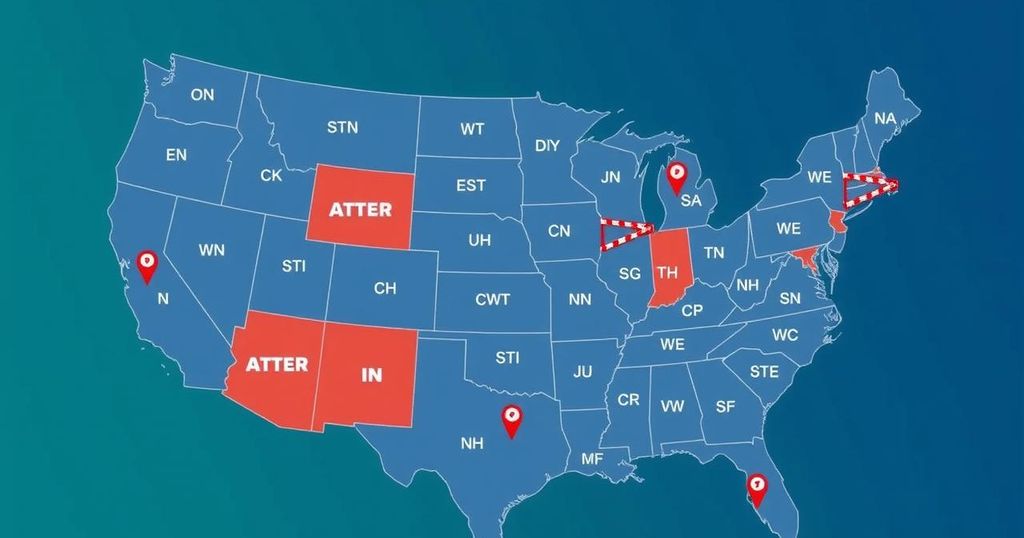Analyzing Key House Races on Election Night for Insight into National Trends

The upcoming election presents decisive House races that will significantly influence the balance of power in Congress. Democrats need four additional seats to regain control, with key districts in Virginia, North Carolina, New York, and California serving as indicators of broader electoral trends. Shifts in support among Black and Hispanic voters, as well as the engagement levels of suburban and college-educated constituents, will be essential in understanding the outcomes on Election Night.
As the United States embarks on another consequential presidential election, attention must also be directed towards the pivotal races for the House of Representatives. According to Mr. Kondik, a noted American elections analyst, the Democrats have an approximately fifty percent chance of regaining control of the House, necessitating the acquisition of four additional seats to reach a majority of 218, accounting for current vacancies in steadfastly Democratic regions. Interestingly, historical patterns reveal that victories in presidential and congressional elections are often aligned; however, this year may witness an anomaly whereby the Republican Party could secure the presidency while simultaneously ceding control of the House—an occurrence unprecedented since the party’s inception. Recent trends indicate that the correlation between House results and presidential outcomes has strengthened, further emphasizing the relevance of selected House races on Election Night in forecasting broader electoral sentiments. The evening’s tone may be set as early as 7:00 PM with the closure of polls in Virginia. Notwithstanding its lack of status as a primary battleground for the presidency, Virginia is hosting competitive House races that warrant attention. In the Second District, anchored in Virginia Beach, the Republican incumbent, Jen Kiggans, faces a challenging environment in a district that narrowly favored Biden in past elections. Adjacent to this, in Northern Virginia, Democrats are defending the Seventh District, where Biden’s support exceeded the national average in the previous election cycle. Shifting focus to North Carolina, the First District, represented by Democrat Don Davis, is particularly significant in evaluating Democratic strength among Black voters. Although African American voters have traditionally supported Democrats, there are indications of diminishing allegiance among younger demographics, which could manifest in crucial districts won by Biden in the previous election cycle. A tight race or a loss for Davis could signal trouble for Democratic prospects in similarly diverse swing districts. Control of the House may hinge on outcomes in key districts located in New York and California, both of which comprise areas where Republican incumbents currently hold seats that Biden won in 2020. For instance, New York’s 19th District is identified as a tossup, with Democrats needing to flip this competitive seat to bolster their majority aspirations. In a similar vein, California’s 13th District represents a prime target for Democrats, and a failure to capture it may signal stronger Republican resilience in traditionally Democratic territories. Moreover, the evolving dynamics of Hispanic voter support is crucial to note, particularly in California’s 13th District, where shifts towards Republican candidates could illuminate broader trends. Parallel narratives exist within Pennsylvania’s Seventh District where Puerto Rican voter turnout is a key component of the electoral calculus, particularly following inflammatory comments made at a high-profile political rally. Consequently, the performance of candidates in districts that directly correspond with electoral votes will reveal insights into both local and national political landscapes. Examining congressional races in Maine and Nebraska can serve as an indicator of how college-educated and suburban voters respond to prevailing narratives. Ultimately, the intricate relationships between individual district outcomes and broader election results will offer electoral analysts a clearer picture of the impending electoral landscape, encapsulating both the presidential contest and the future composition of the House of Representatives. This comprehensive examination of House races will not only guide predictions for the night’s outcomes but also provide clarity on shifting voter allegiances across demographic lines.
The dynamics of the 2024 presidential election are not only crucial for the presidency but also for control of the U.S. House of Representatives. With Democrats vying to regain their majority, the interplay between presidential and congressional races becomes critical. As historical patterns suggest that the party controlling the presidency often influences House races, analysts are closely scrutinizing specific districts that could foreshadow electoral trends. Understanding voter demographics, such as the support of Black and Hispanic voters, as well as shifts in suburban and college-educated electorates, is essential for deciphering the political landscape on Election Night.
In conclusion, as the electoral process unfolds, the outcomes of selected House races will substantially inform not only the composition of the House but also provide predictive insights into the presidential election. By analyzing critical districts and voter behavior, it becomes evident that the political landscape is in flux, with potential implications for both parties. The intricate interplay between these races underscores the importance of continual voter engagement and analysis to understand the shifting tides in American politics.
Original Source: www.nytimes.com







